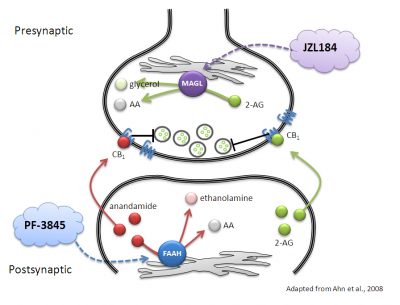Cannabinoids are compounds that are similar to those compounds found in the Cannabis (i.e., marijuana) plant. Cannabinoids are categorized based on their origin:
1. Phytocannabinoids are plant-based cannabinoids. Some examples are delta-9 tetrahydrocannabinol (THC), which is the primary psychoactive component of marijuana, cannabidiol, and cannabichromene. The possible physiological effects of the nearly 100 other phytocannabinoids is unknown.
2. Synthetic cannabinoids are laboratory produced compounds that are known to bind to cannabinoid receptors. These synthetic cannabinoids have been in the news lately because they are being sold as "incense" to be smoked by people. Synthetic cannabinoids are not intended for human consumption and are dangerous to use because their effects are largely unknown. Many hospitalizations have been reported by people who smoke synthetic cannabinoids.
3. Endocannabinoids are cannabinoids that are naturally produced in the body (that is, endogenously produced).
The endocannabinoid system
The endogenous cannabinoid (i.e., endocannabinoid) system consists of:
1. Two cloned cannabinoid receptors (CB1 and CB2)
2. The endocannabinoids anandamide and 2-arachidonylglycerol (2-AG). In addition, there are some other compounds that have been shown to bind to CB1 and CB2 but may have limited effects in live animals.
3. The enzymes that regulate the biosynthesis and catabolism of the endocannabinoids. For example, fatty acid amide hydrolase (FAAH) metabolizes anandamide into ethanolamine and arachydonic acid (AA), whereas monoacylglycerol lipase (MAGL) is the primary enzyme responsible for metabolizing 2-AG into glycerol and arachydonic acid.

Effects of endocannabinoids
Systemic administration of anandamide or 2-AG has limited efficacy in animals, because these endocannabinoids are so rapidly degraded by FAAH or MAGL (along with ABHD6 and ABHD12), respectively. However, pharmacological inhibiton of FAAH, for example with the Pfizer compound PF-3845, increases tissue levels of anandamide as well as some other fatty acid amides that FAAH hydrolizes. Similarly, the inhibition of MAGL, for example with the compound JZL184, increases tissue levels of 2-AG. Alterations in endocannabinoid levels affect a broad range of physiological and behavioral systems. Our lab as well as others have demonstrated that PF-3845 and JZL184 produce a range of effects including analgesia and decreases in anxiety-like behaviors.
For further reading, please see my article in The Conversation.